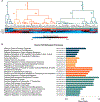Spinal Cord Injury Impairs Lung Immunity in Mice
- PMID: 35697382
- PMCID: PMC9246940
- DOI: 10.4049/jimmunol.2200192
Spinal Cord Injury Impairs Lung Immunity in Mice
Abstract
Pulmonary infection is a leading cause of morbidity and mortality after spinal cord injury (SCI). Although SCI causes atrophy and dysfunction in primary and secondary lymphoid tissues with a corresponding decrease in the number and function of circulating leukocytes, it is unknown whether this SCI-dependent systemic immune suppression also affects the unique tissue-specific antimicrobial defense mechanisms that protect the lung. In this study, we tested the hypothesis that SCI directly impairs pulmonary immunity and subsequently increases the risk for developing pneumonia. Using mouse models of severe high-level SCI, we find that recruitment of circulating leukocytes and transcriptional control of immune signaling in the lung is impaired after SCI, creating an environment that is permissive for infection. Specifically, we saw a sustained loss of pulmonary leukocytes, a loss of alveolar macrophages at chronic time points postinjury, and a decrease in immune modulatory genes, especially cytokines, needed to eliminate pulmonary infections. Importantly, this injury-dependent impairment of pulmonary antimicrobial defense is only partially overcome by boosting the recruitment of immune cells to the lung with the drug AMD3100, a Food and Drug Administration-approved drug that mobilizes leukocytes and hematopoietic stem cells from bone marrow. Collectively, these data indicate that the immune-suppressive effects of SCI extend to the lung, a unique site of mucosal immunity. Furthermore, preventing lung infection after SCI will likely require novel strategies, beyond the use of orthodox antibiotics, to reverse or block tissue-specific cellular and molecular determinants of pulmonary immune surveillance.
Copyright © 2022 by The American Association of Immunologists, Inc.
Conflict of interest statement
Figures








Similar articles
-
Spinal cord injury enhances lung inflammation and exacerbates immune response following exposure to LPS.Front Immunol. 2025 Jan 15;15:1483402. doi: 10.3389/fimmu.2024.1483402. eCollection 2024. Front Immunol. 2025. PMID: 39882237 Free PMC article.
-
Chronic spinal cord injury attenuates influenza virus-specific antiviral immunity.J Neuroinflammation. 2016 May 31;13(1):125. doi: 10.1186/s12974-016-0574-y. J Neuroinflammation. 2016. PMID: 27245318 Free PMC article.
-
Attenuating Neurogenic Sympathetic Hyperreflexia Robustly Improves Antibacterial Immunity After Chronic Spinal Cord Injury.J Neurosci. 2020 Jan 8;40(2):478-492. doi: 10.1523/JNEUROSCI.2417-19.2019. Epub 2019 Nov 21. J Neurosci. 2020. PMID: 31754014 Free PMC article.
-
The paradox of chronic neuroinflammation, systemic immune suppression, autoimmunity after traumatic chronic spinal cord injury.Exp Neurol. 2014 Aug;258:121-129. doi: 10.1016/j.expneurol.2014.04.023. Exp Neurol. 2014. PMID: 25017893 Free PMC article. Review.
-
Immune dysfunction after spinal cord injury - A review of autonomic and neuroendocrine mechanisms.Curr Opin Pharmacol. 2022 Jun;64:102230. doi: 10.1016/j.coph.2022.102230. Epub 2022 Apr 27. Curr Opin Pharmacol. 2022. PMID: 35489214 Free PMC article. Review.
Cited by
-
Spinal cord injury enhances lung inflammation and exacerbates immune response following exposure to LPS.Front Immunol. 2025 Jan 15;15:1483402. doi: 10.3389/fimmu.2024.1483402. eCollection 2024. Front Immunol. 2025. PMID: 39882237 Free PMC article.
-
Unraveling the lymphatic system in the spinal cord meninges: a critical element in protecting the central nervous system.Cell Mol Life Sci. 2023 Nov 20;80(12):366. doi: 10.1007/s00018-023-05013-1. Cell Mol Life Sci. 2023. PMID: 37985518 Free PMC article. Review.
-
System failure: Systemic inflammation following spinal cord injury.Eur J Immunol. 2024 Jan;54(1):e2250274. doi: 10.1002/eji.202250274. Epub 2023 Oct 19. Eur J Immunol. 2024. PMID: 37822141 Free PMC article. Review.
References
-
- DeVivo MJ, Black KJ, and Stover SL. 1993. Causes of death during the first 12 years after spinal cord injury. Arch. Phys. Med. Rehabil. 74: 248–54. - PubMed
-
- Strauss DJ, DeVivo MJ, Paculdo DR, and Shavelle RM. 2006. Trends in Life Expectancy After Spinal Cord Injury. Arch. Phys. Med. Rehabil. 87: 1079–1085. - PubMed
-
- Failli V, Kopp MA, Gericke C, Martus P, Klingbeil S, Brommer B, Laginha I, Chen Y, DeVivo MJ, Dirnagl U, and Schwab JM. 2012. Functional neurological recovery after spinal cord injury is impaired in patients with infections. Brain 135: 3238–3250. - PubMed
-
- Savic G, DeVivo MJ, Frankel HL, Jamous MA, Soni BM, and Charlifue S. 2017. Long-term survival after traumatic spinal cord injury: a 70-year British study. Spinal Cord 55: 651–658. - PubMed
Publication types
MeSH terms
Substances
Grants and funding
LinkOut - more resources
Full Text Sources
Medical

